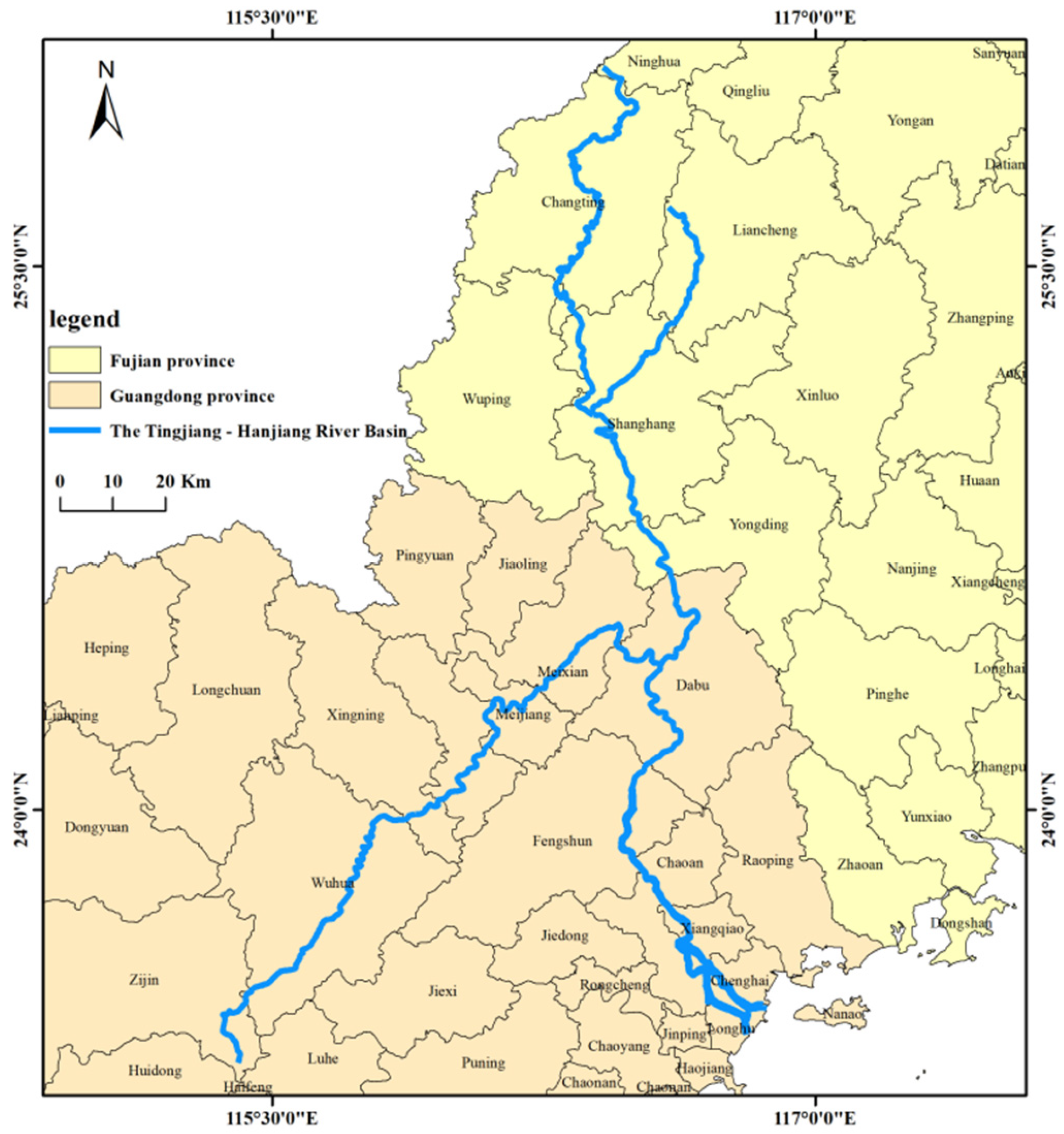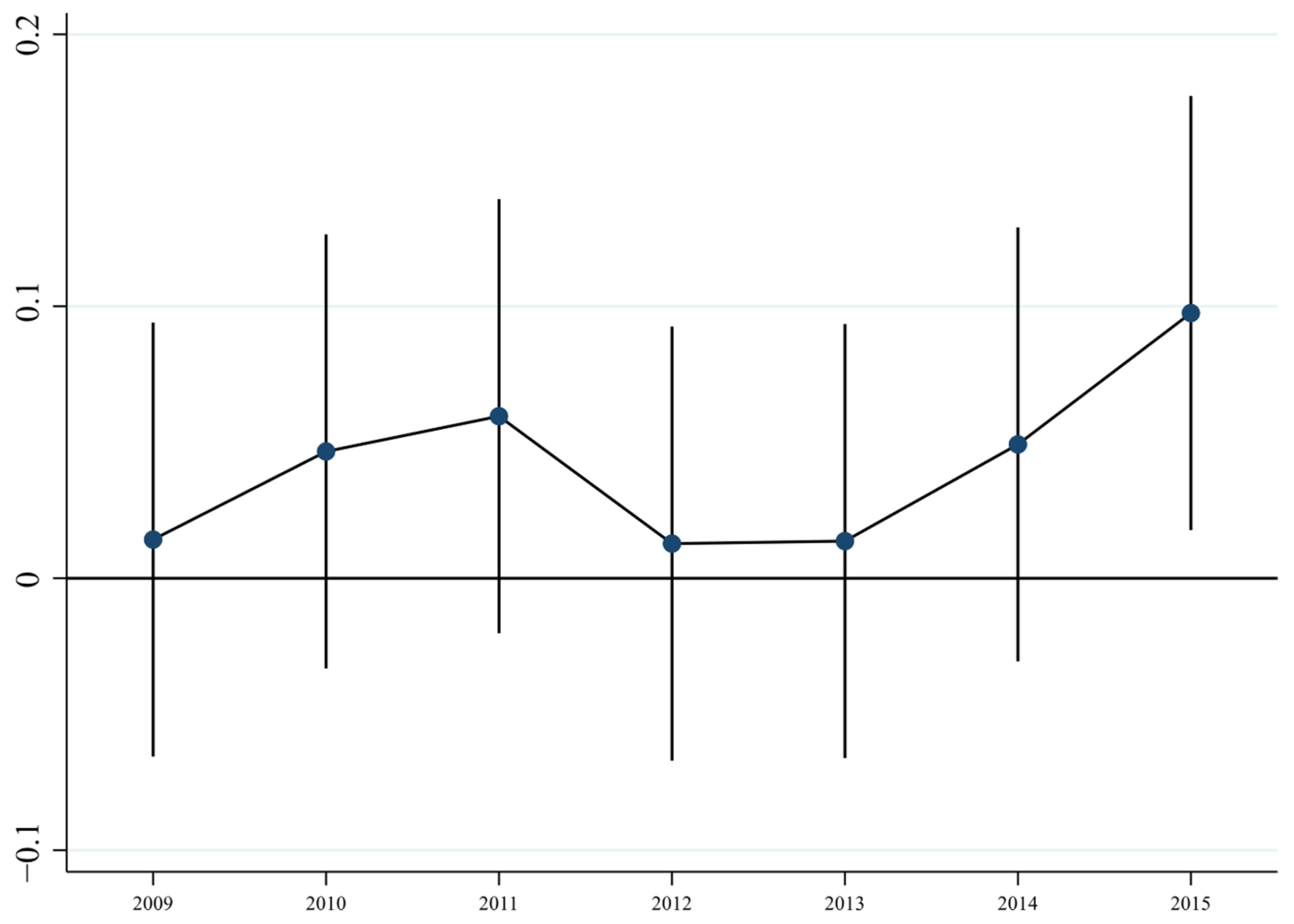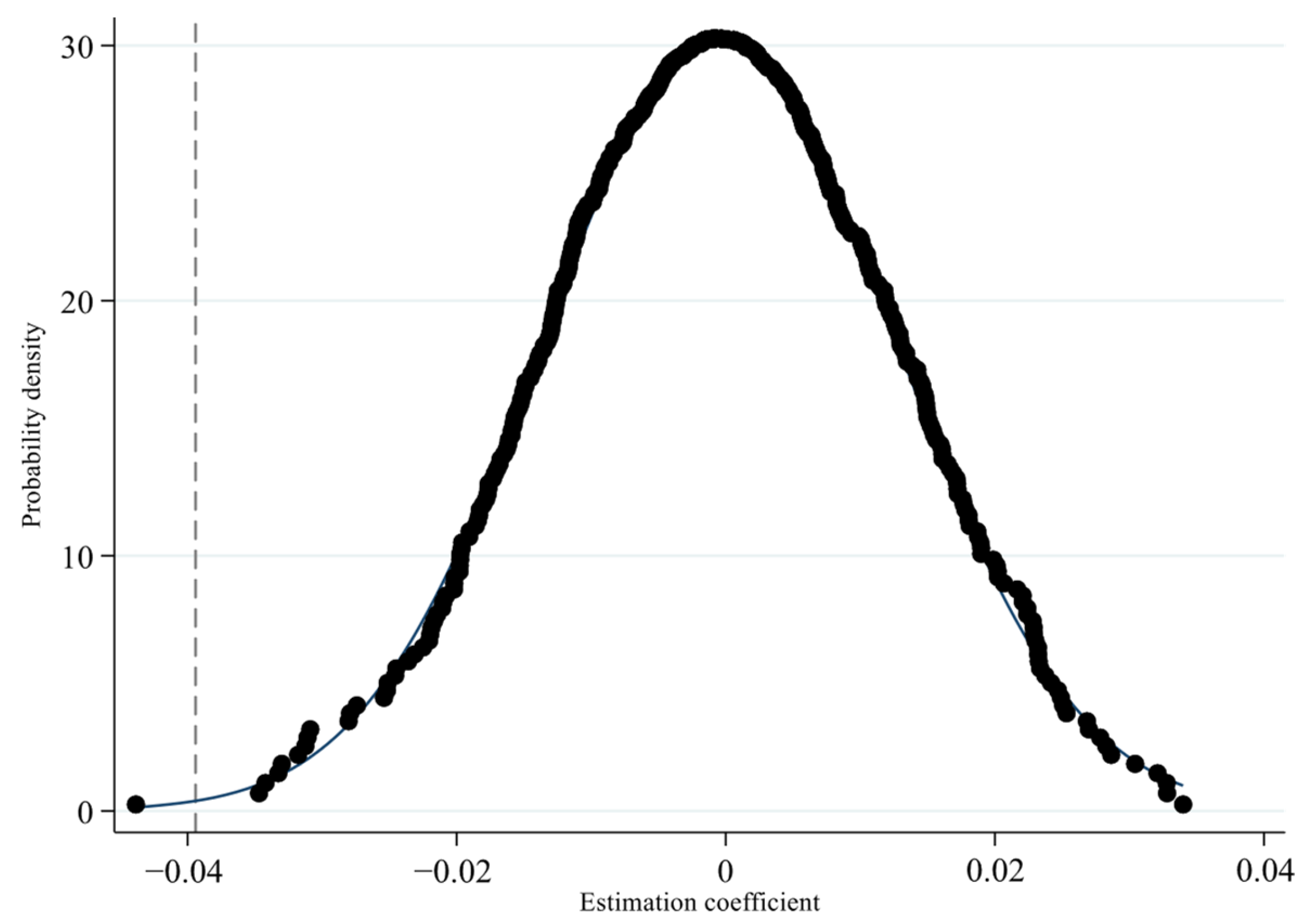Does Basin Ecological Compensation Promote Green Economic Development in the Compensated Area?—A Quasi-Natural Experiment Focusing on the Tingjiang-Hanjiang River Basin, China
Abstract
1. Introduction
2. Research Design
2.1. River Basin Research
2.2. Model Design
2.3. Measurement of Green Economic Development Level and Model Setting
2.3.1. The Theoretical Framework of Green Economic Development
2.3.2. Super-Efficiency SBM Model
2.3.3. GML Index Model
2.4. Variable Description and Descriptive Statistics
2.4.1. Explained Variable
2.4.2. Core Explanatory Variable
2.4.3. Control Variables
2.4.4. Mediating Variable
2.4.5. Data Source
3. Empirical Analysis Results
3.1. Impact of Basin WEC Policy on Green Economic Development
3.2. Parallel Trend Test
3.3. Robustness Test
3.3.1. PSM-DID Estimation
3.3.2. Placebo Test
3.3.3. Counterfactual Test
3.4. Heterogeneity Analysis
3.5. Mechanism Test of Technological Innovation
4. Discussion
5. Conclusions and Recommendations
Author Contributions
Funding
Institutional Review Board Statement
Informed Consent Statement
Data Availability Statement
Conflicts of Interest
References
- Wang, Z.Z.; Mao, X.Q.; Zeng, W.H.; Xie, Y.X.; Ma, B.R. Exploring the influencing paths of natives’ conservation behavior and policy incentives in protected areas: Evidence from China. Sci. Total Environ. 2020, 744, 140728. [Google Scholar] [CrossRef]
- D’amato, D.; Korhonen, J. Integrating the green economy, circular economy and bioeconomy in a strategic sustainability framework. Ecol. Econ. 2021, 188, 107143. [Google Scholar] [CrossRef]
- Guan, X.J.; Liu, M.; Meng, Y. A comprehensive ecological compensation indicator based on pollution damage–protection bidirectional model for river basin. Ecol. Indic. 2021, 126, 107708. [Google Scholar] [CrossRef]
- Wang, H.J.; Dong, Z.F.; Xu, Y.; Ge, C.Z. Eco-compensation for watershed services in China. Water Int. 2016, 41, 271–289. [Google Scholar] [CrossRef]
- Xu, H.; Chen, L.X.; Li, Q.F. Research on two-way ecological compensation strategy for transboundary watershed based on differential game. J. Environ. Manag. 2024, 371, 123314. [Google Scholar] [CrossRef] [PubMed]
- Hu, H.; Tian, G.L.; Wu, Z.; Xia, Q. Cross-regional ecological compensation under the composite index of water quality and quantity: A case study of the Yellow River Basin. Environ. Res. 2023, 238, 117152. [Google Scholar] [CrossRef]
- Jiang, K.; Zhang, J.M.; Zhang, L.L.; Wang, D.; Wang, Y.S. Sustainable cooperation in the watershed ecological compensation public-private partnership project: Lessons from China’s Chishui river basin. Socio-Econ. Plan. Sci. 2023, 90, 101730. [Google Scholar] [CrossRef]
- Ding, J.P.; Chen, L.X.; Deng, M.H.; Chen, J.F. A differential game for basin ecological compensation mechanism based on cross-regional government-enterprise cooperation. J. Clean. Prod. 2022, 362, 132335. [Google Scholar] [CrossRef]
- Yu, J.; Qin, X.; Cheng, S.L.; Chen, J.D. Horizontal ecological compensation policy and water pollution governance: Evidence from cross-border cooperation in China. Environ. Impact Assess. Rev. 2024, 105, 107367. [Google Scholar] [CrossRef]
- Dong, X.; Jiang, K. Does individuals’ expected policy utility drive watershed ecological compensation in China’s Xin’an river basin pilot? Ocean. Coast. Manag. 2025, 269, 107797. [Google Scholar] [CrossRef]
- Chen, H.T.; Wang, C.C.; Lv, Z.F.; Zhong, Y.; Ren, Q.R.; Ren, J.X.; Wang, Y.Q.; Liu, X.; Luo, L.C. Long-term water quality dynamics and influencing factors under ecological compensation mechanisms: A case study of China’s first cross-provincial ecological compensation watershed. J. Environ. Manag. 2025, 380, 125142. [Google Scholar] [CrossRef] [PubMed]
- Yang, Q.Y.; Zhen, Y.; Chen, Y.M. The impact of trans-provincial watershed eco-compensation policy on carbon emissions: Evidence from China. Econ. Anal. Policy 2024, 82, 784–802. [Google Scholar] [CrossRef]
- Chen, C.; Zhou, Z.X.; Li, C.; Liu, W. Ecological compensation and breakthrough innovation: Evidence from heavily polluting firms. J. Environ. Manag. 2025, 392, 126682. [Google Scholar] [CrossRef] [PubMed]
- Chen, H.T.; Wang, C.C.; Ren, Q.R.; Liu, X.; Ren, J.X.; Kang, G.L.; Wang, Y.Q. Long-term water quality dynamics and trend assessment reveal the effectiveness of ecological compensation: Insights from China’s first cross-provincial compensation watershed. Ecol. Indic. 2024, 169, 112853. [Google Scholar] [CrossRef]
- Yi, Y.X.; Yang, M.; Fu, C.Y.; Li, C. Transboundary pollution control with ecological compensation in a watershed containing multiple regions: A dynamic analysis. Water Resour. Econ. 2024, 46, 100242. [Google Scholar] [CrossRef]
- Wang, C.C.; Ling, J.J.; Liu, Y.B.; Liu, B.L.; Nan, D. Can air quality ecological compensation improve environmental welfare performance? Based on the “Win–Win–Win” perspective of economy–ecology–welfare. J. Clean. Prod. 2025, 489, 144604. [Google Scholar] [CrossRef]
- Wan, L.; Zheng, Q.Q.; Jie, W.; Wei, Z.Y.; Wang, S.Y. How does the ecological compensation mechanism adjust the industrial structure? Evidence from China. J. Environ. Manag. 2022, 301, 113839. [Google Scholar] [CrossRef]
- Li, H.L.; Wen, Z.M.; Wan, Y.M.; Hu, J.X. How does the horizontal watershed ecological compensation mechanism effect regional economy?—A county level empirical study on xin’an River basin, China. Ecol. Indic. 2024, 166, 112506. [Google Scholar] [CrossRef]
- Wang, H.H.; Xiong, J.X. Governance on water pollution: Evidence from a new river regulatory system of China. Econ. Model. 2022, 113, 105878. [Google Scholar] [CrossRef]
- Wang, J.M.; Wang, L.X. Study on the efficiency of air pollution control and responsibility allocation in the Yangtze River Delta region in China from the perspective of ecological compensation. J. Clean. Prod. 2023, 423, 138700. [Google Scholar] [CrossRef]
- Jing, P.R.; Sheng, J.B.; Hu, T.S.; Mahmoud, A.; Huang, Y.F.; Li, X.; Liu, Y.; Wang, Y.; Shu, Z.K. Emergy-based sustainability evaluation model of hydropower megaproject incorporating the social-economic-ecological losses. J. Environ. Manag. 2023, 344, 118402. [Google Scholar] [CrossRef]
- Li, Z.H.; Wang, Y.L. Tourism industry development, rural digitalization, and green total factor productivity. Financ. Res. Lett. 2025, 81, 107419. [Google Scholar] [CrossRef]
- Shen, Z.Y.; Wu, H.T.; Bai, K.X.; Hao, Y. Integrating economic, environmental and societal performance within the productivity measurement. Technol. Forecast. Soc. Chang. 2022, 176, 121463. [Google Scholar] [CrossRef]
- Yun, D.; Jia, Z.Q. An investigation into the connection between green total factor productivity in agriculture and high-quality agricultural progress: Based on the mechanism of regional financial development. Financ. Res. Lett. 2025, 81, 107324. [Google Scholar] [CrossRef]
- Li, S.J.; Yin, Y.K.; Jiao, Z.Y.; Zhao, Q.Y. Financial investment and green development: How does financialization affect green total factor productivity? Financ. Res. Lett. 2025, 78, 107258. [Google Scholar] [CrossRef]
- Cui, X.; Li, P.R. Digital economy, environmental expenditure, and green total factor productivity. Financ. Res. Lett. 2025, 73, 106624. [Google Scholar] [CrossRef]
- Chen, H.F.; Niu, D.X.; Gao, Y.B. Research on the impact of energy transition policies on green total factor productivity of Chinese high-energy-consuming enterprises. Energy 2025, 319, 135066. [Google Scholar] [CrossRef]
- Liu, L.; Zhao, S.M. Local government debt, financing constraints and firms’ green total factor productivity. Int. Rev. Financ. Anal. 2025, 97, 103874. [Google Scholar] [CrossRef]
- Guan, X.J.; Ruan, T.H.; Meng, Y.; Zhang, H.; Wei, J.L. Ecological compensation mechanism controlled by both river ecological water demand and regional water rights. Sci. Total Environ. 2024, 954, 176137. [Google Scholar] [CrossRef]
- Zheng, Q.Q.; Wan, L.; Wang, S.Y.; Wang, C.Y.; Fang, W.P. Does ecological compensation have a spillover effect on industrial structure upgrading? Evidence from China based on a multi-stage dynamic DID approach. J. Environ. Manag. 2021, 294, 112934. [Google Scholar] [CrossRef]
- Zhao, F.; Shu, X.; Zhao, X.; Guo, M.W. Determinants and action paths of transboundary water pollution collaborative governance: A case study of the Yangtze River Basin, China. J. Environ. Manag. 2024, 360, 121217. [Google Scholar] [CrossRef] [PubMed]
- Liu, W.H.; Xie, T.; Wei, X. County-to-City Upgrading, Administrative Power Expansion, and Industrial Land Prices. Econ. Sci. 2022, 6, 39–55. [Google Scholar]
- Jiang, T. Mediation Effects and Moderation Effects in Empirical Causal Inference Research. China Ind. Econ. 2022, 5, 100–120. (In Chinese) [Google Scholar] [CrossRef]
- Tone, K. A slacks-based measure of efficiency in data envelopment analysis. Eur. J. Oper. Res. 2001, 3, 498–509. [Google Scholar] [CrossRef]
- Tone, K. A slacks-based measure of super-efficiency in data envelopment analysis. Eur. J. Oper. Res. 2002, 143, 32–41. [Google Scholar] [CrossRef]
- Oh, D. A global Malmguist-Luenberger productivity index. J. Prod. Anal. 2010, 34, 183–197. [Google Scholar] [CrossRef]
- Peng, S.Y.; Yu, Y.J. Green development efficiency measurement and influencing factors analysis in the Yangtze River economic Belt, China. Ecol. Indic. 2024, 162, 112025. [Google Scholar] [CrossRef]
- Qian, J.L.; Zhou, Y.X.; Hao, Q.Y. The effect and mechanism of digital economy on green total factor productivity—Empirical evidence from China. J. Environ. Manag. 2024, 372, 123237. [Google Scholar] [CrossRef]
- Hunjra, A.I.; Zhao, S.K.; Tan, Y.; Bouri, E.; Liu, X.M. How do green innovations promote regional green total factor productivity? Multidimensional analysis of heterogeneity, spatiality and nonlinearity. J. Clean. Prod. 2024, 467, 142935. [Google Scholar] [CrossRef]
- Yuan, C.L.; Shang, M.L.; Han, Z.J.; Wang, J.T. Research on the impact of the national ecological demonstration zone on green total factor productivity: Evidence from China. J. Environ. Manag. 2024, 356, 120421. [Google Scholar] [CrossRef]
- Stratoulias, D.; Jang, B.; Nuthammachot, N. Evaluation of urban PM2. 5 concentrations over 73 major cities and their association with satellite Aerosol Optical Depth: A global analysis of ambient air pollution. Atmos. Pollut. Res. 2025, 16, 102556. [Google Scholar] [CrossRef]
- Yang, J.H.; Liu, P.X.; Zhong, F.L.; Han, N. Subway opening enables urban green development: Evidence from difference-in-differences and double dual machine learning methods. J. Environ. Manag. 2025, 375, 124177. [Google Scholar] [CrossRef] [PubMed]
- Ma, J.Q.; Wang, A.B.; Weng, Z.Y. Do policies make a difference? Assessing the impact of China’s air pollution prevention and control action plan on carbon emissions. J. Environ. Manag. 2024, 370, 122685. [Google Scholar] [CrossRef] [PubMed]
- Wei, W.W.; Nan, S.X.; Xie, B.B.; Liu, C.F.; Zhou, J.J.; Liu, C.Y. The spatial-temporal changes of supply-demand of ecosystem services and ecological compensation: A case study of Hexi Corridor, Northwest China. Ecol. Eng. 2023, 187, 106861. [Google Scholar] [CrossRef]
- Huang, G.F.; Wu, S.Y.; Chen, L.H. The Belt and Road Initiative, Outward Foreign Direct Investment, and Technological Innovation. Financ. Res. Lett. 2025, 77, 106997. [Google Scholar] [CrossRef]
- Jacobson, L.S.; LaLonde, R.J.; Sullivan, D.G. Earnings losses of displaced workers. Am. Econ. Rev. 1993, 83, 685–709. Available online: https://www.jstor.org/stable/2117574 (accessed on 16 August 2025).
- Ye, M.J.; Liao, L.Y.; Fu, T.Q.; Lan, S.R. Do establishment of protected areas and implementation of regional policies both promote the forest NPP? Evidence from Wuyi Mountain in China based on PSM-DID. Glob. Ecol. Conserv. 2024, 55, e03210. [Google Scholar] [CrossRef]
- Ge, P.F.; Liu, T.; Huang, X.L. The effects and drivers of green financial reform in promoting environmentally-biased technological progress. J. Environ. Manag. 2023, 339, 117915. [Google Scholar] [CrossRef]
- André, F.J.; Ranocchia, C.; Rubio, S.J. Porter Hypothesis vs. Pollution Haven Hypothesis: Can an environmental policy generate a win-win solution? Energy Econ. 2025, 146, 108477. [Google Scholar] [CrossRef]
- Zhang, Y.J.; Song, Y.; Zou, H. Non-linear effects of heterogeneous environmental regulations on industrial relocation: Do compliance costs work? J. Environ. Manag. 2022, 323, 116188. [Google Scholar] [CrossRef]
- Acemoglu, D.; Aghion, P.; Bursztyn, L. The environment and directed technical change. Am. Econ. Rev. 2012, 102, 131–166. [Google Scholar] [CrossRef]




| Variable | Obs | Mean | St | Min | Max |
|---|---|---|---|---|---|
| 1904 | 1.049 | 0.148 | 0.319 | 2.321 | |
| 1904 | 0.047 | 0.061 | 0.006 | 0.487 | |
| 1904 | 1.067 | 0.694 | 0.202 | 6.544 | |
| 1904 | 0.671 | 0.452 | 0.052 | 5.483 | |
| 1904 | 0.129 | 0.047 | 0.034 | 1.100 | |
| 1904 | 0.003 | 0.002 | 0.001 | 0.018 | |
| 1904 | 555.389 | 2098.190 | 0.000 | 30,470.000 |
| Variable | (1) | (2) | (3) | (4) |
|---|---|---|---|---|
| −0.0394 ** | −0.0397 ** | −0.0394 ** | −0.0359 * | |
| (0.0190) | (0.0190) | (0.0186) | (0.0189) | |
| No | Yes | No | Yes | |
| No | No | Yes | Yes | |
| No | No | Yes | Yes | |
| 1.020 *** | 0.785 *** | 1.031 *** | 0.919 *** | |
| (0.00446) | (0.0782) | (0.0357) | (0.263) | |
| 1904 | 1904 | 1904 | 1904 | |
| R2 | 0.045 | 0.053 | 0.151 | 0.153 |
| Variable | Proximity Matching | Radius Matching | Kernel Matching |
|---|---|---|---|
| (1) | (2) | (3) | |
| −0.0364 * | −0.0331 * | −0.0289 ** | |
| (0.0212) | (0.0196) | (0.0123) | |
| Yes | Yes | Yes | |
| Yes | Yes | Yes | |
| Yes | Yes | Yes | |
| 1.047 *** | 1.371 *** | 1.019 *** | |
| (0.141) | (0.202) | (0.00610) | |
| 1723 | 1632 | 1553 | |
| R2 | 0.139 | 0.159 | 0.027 |
| Variable | (1) | (2) | (3) | (4) |
|---|---|---|---|---|
| −0.0212 | −0.0217 | −0.0212 | −0.0173 | |
| (0.0192) | (0.0192) | (0.0189) | (0.0190) | |
| No | Yes | No | Yes | |
| No | No | Yes | Yes | |
| No | No | Yes | Yes | |
| 1.018 *** | 0.776 *** | 1.032 *** | 0.926 *** | |
| (0.00483) | (0.0784) | (0.0357) | (0.263) | |
| 1904 | 1904 | 1904 | 1904 | |
| R2 | 0.039 | 0.048 | 0.149 | 0.152 |
| Variable | (1) | (2) |
|---|---|---|
| −0.0359 * | −305.4 *** | |
| (0.0189) | (88.22) | |
| Yes | Yes | |
| Yes | Yes | |
| Yes | Yes | |
| 0.919 *** | 6.691 *** | |
| (0.263) | (1.229) | |
| 1904 | 1904 | |
| R2 | 0.153 | 0.776 |
Disclaimer/Publisher’s Note: The statements, opinions and data contained in all publications are solely those of the individual author(s) and contributor(s) and not of MDPI and/or the editor(s). MDPI and/or the editor(s) disclaim responsibility for any injury to people or property resulting from any ideas, methods, instructions or products referred to in the content. |
© 2025 by the authors. Licensee MDPI, Basel, Switzerland. This article is an open access article distributed under the terms and conditions of the Creative Commons Attribution (CC BY) license (https://creativecommons.org/licenses/by/4.0/).
Share and Cite
Pan, Y.; Yang, A.; Zhang, B. Does Basin Ecological Compensation Promote Green Economic Development in the Compensated Area?—A Quasi-Natural Experiment Focusing on the Tingjiang-Hanjiang River Basin, China. Sustainability 2025, 17, 7538. https://doi.org/10.3390/su17167538
Pan Y, Yang A, Zhang B. Does Basin Ecological Compensation Promote Green Economic Development in the Compensated Area?—A Quasi-Natural Experiment Focusing on the Tingjiang-Hanjiang River Basin, China. Sustainability. 2025; 17(16):7538. https://doi.org/10.3390/su17167538
Chicago/Turabian StylePan, Yunru, Aijun Yang, and Bicheng Zhang. 2025. "Does Basin Ecological Compensation Promote Green Economic Development in the Compensated Area?—A Quasi-Natural Experiment Focusing on the Tingjiang-Hanjiang River Basin, China" Sustainability 17, no. 16: 7538. https://doi.org/10.3390/su17167538
APA StylePan, Y., Yang, A., & Zhang, B. (2025). Does Basin Ecological Compensation Promote Green Economic Development in the Compensated Area?—A Quasi-Natural Experiment Focusing on the Tingjiang-Hanjiang River Basin, China. Sustainability, 17(16), 7538. https://doi.org/10.3390/su17167538






